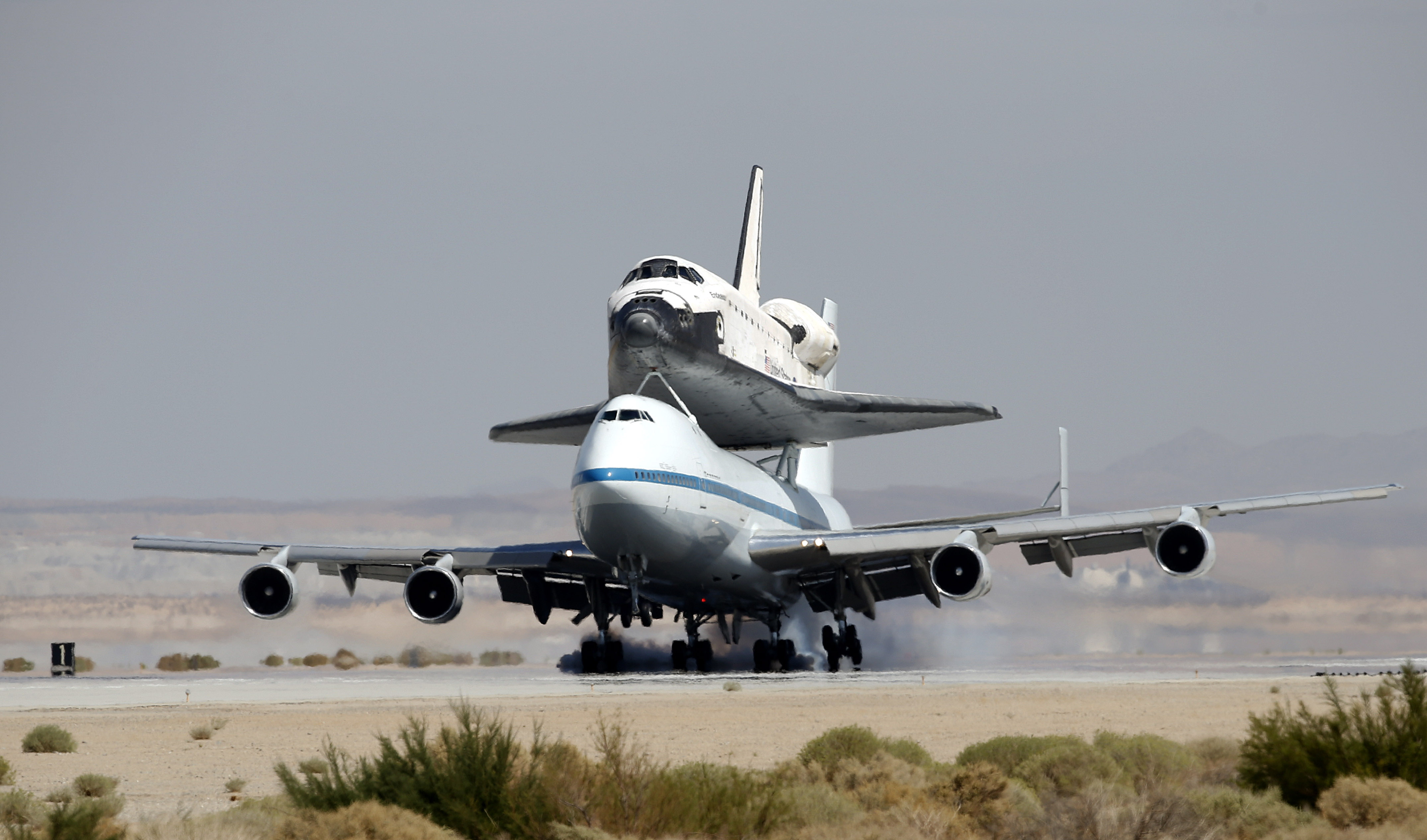By ALICIA CHANG and PAUL DAVENPORT
Associated Press
LOS ANGELES - Space shuttle Endeavour returned to its California roots Thursday after a wistful cross-country journey that paid homage to NASA workers and former Arizona Rep. Gabrielle Giffords and her astronaut husband.
"That's my spaceship," said Endeavour's last commander, Mark Kelly, as the couple watched the shuttle loop over Tucson, Ariz.
Later in the day, a 747 jet carrying Endeavour swooped out of the desert sky and glided down a concrete runway at Edwards Air Force Base, 100 miles north of Los Angeles, not far from where the now-retired shuttle fleet was assembled.
The shuttle and jumbo jet take off again at sunrise Friday to make low, sweeping passes over Sacramento, San Francisco, Silicon Valley and Los Angeles.
Next stop: Los Angeles International Airport where Endeavour will be prepped for a slow ride on a special flatbed trailer through city streets next month to its final destination as a museum showpiece.
Endeavour's highly anticipated homecoming was twice delayed by stormy weather along the Gulf of Mexico. Early Wednesday, it departed from its Cape Canaveral, Fla., home base, soared over NASA centers in Mississippi and Louisiana, and made a layover in Houston, home of Mission Control. Crowds craned their necks skyward as the shuttle circled low over Florida's Space Coast and Houston.
After refueling in El Paso, Texas, Thursday, it flew over the White Sands Test Facility in New Mexico, an emergency shuttle landing site used once. Kelly requested that Endeavour pass over Tucson to honor Giffords, who is recovering after suffering a head wound in a shooting rampage last year. Before retiring from her House seat, she was a member of the House committee on science, space and technology.
The couple watched from the roof of a University of Arizona parking garage.
Former Giffords aide C.J. Karamargin said Giffords was "elated" and started "hooting and hollering" when she spotted Endeavour.
Kelley said seeing the shuttle reminded him how difficult it was to land.
"Landing a space shuttle is not easy," he said. "It doesn't glide very well."
Endeavour's maiden voyage into space two decades ago ended with a planned touchdown at NASA's Dryden Flight Research Center based at Edwards. Unlike a return from orbit, no ear-splitting twin sonic booms accompanied the latest return.
Known as the baby shuttle, Endeavour replaced Challenger, which exploded during liftoff in 1986. NASA lost a second shuttle, Columbia, which broke apart during re-entry in 2003. A replacement was not built. Fourteen astronauts died in the accidents.
Six years after the Challenger tragedy, during Endeavour's first flight, three spacewalking astronauts made a daring rescue of a stranded communications satellite. A year later, it was launched on a service repair mission to the Hubble Space Telescope.
Endeavour flew 25 times, mostly to supply the International Space Station. It spent 299 days in space and circled Earth nearly 4,700 times, logging 123 million miles.
The space shuttle has deep roots in California: The main engines were manufactured in Los Angeles' San Fernando Valley. The heat shield tiles that protected the shuttle during re-entry were invented in Silicon Valley. The shuttle's "fly-by-wire" technology was developed in the Los Angeles suburb of Downey.
Shuttle parts from California and other plants around the country were shipped to Rockwell International's assembly factory in Palmdale near Edwards. In the early days, landings occurred in the desert before switching to Florida. Edwards remained the backup landing site.
Endeavour is the second of three surviving shuttles bound for its retirement home. In April, Discovery landed at the Smithsonian Institution's annex in Virginia after victory laps around the White House, the Capitol and the Washington Monument.
Atlantis will remain in Florida and will be towed in November to the Kennedy Space Center's visitor center.
Enterprise, a prototype that flew in approach and landing tests but never went into space, sailed up the Hudson River by barge in June en route to the Intrepid Sea, Air & Space Museum.
After three decades of service, NASA permanently grounded the shuttles last year under a White House mandate to focus on destinations beyond low-Earth orbit with goals to land astronauts on an asteroid and eventually on Mars. The space agency is relying on Russian rockets to the space station until private companies can provide regular taxi service to the giant orbiting lab.
NASA deeded Endeavour to the California Science Center last year. The estimated coast-to-coast shipping and handling costs is $28 million to be paid for by the science center. A final cost has not been calculated. NASA officials have said it didn't cost extra to fly over Tucson because it was on the way.
After landing at LAX Friday, Endeavour will undergo several weeks of preparations for its last mission: Inching through the streets of Los Angeles in early October to its museum home, a 12-mile crawl that required chopping down hundreds of trees and rerouting power lines.
For shuttle workers, it's a "bittersweet moment. The shuttle is finally retired and done. But for us, it's a great beginning of its next mission," said museum president Jeffrey Rudolph.
